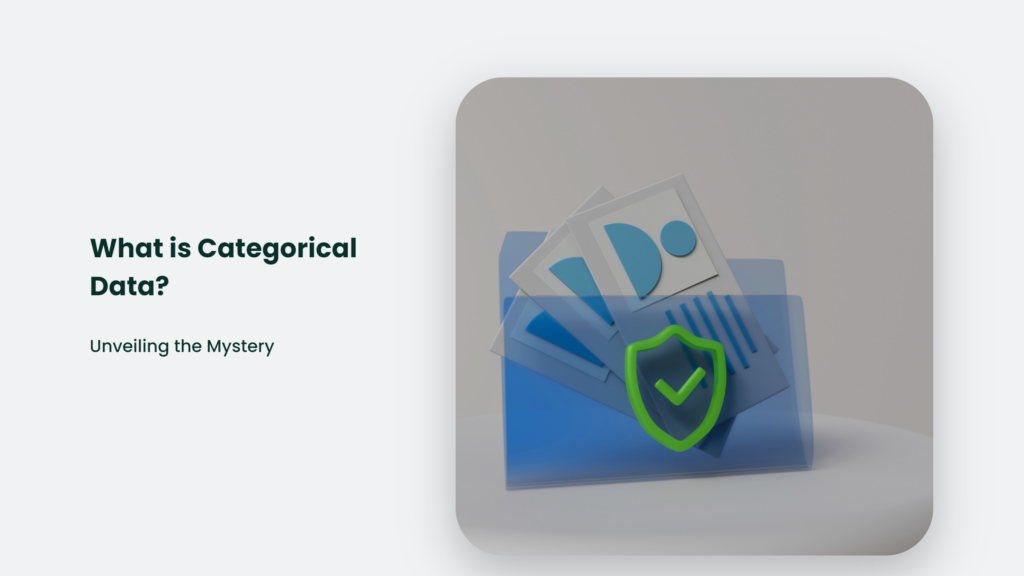Are you ready to unravel the enigmatic world of data? Whether you’re a seasoned data enthusiast or just dipping your toes into the vast ocean of information, understanding the various data types is crucial. In this article, we’ll embark on a journey to demystify “categorical data,” a fundamental concept in data analysis.

The Basics: What is Categorical Data?
At its core, categorical data is a type of data that can be divided into groups or categories. It represents characteristics such as a person’s gender, marital status, or the type of car they drive. Unlike numerical data, measured and expressed in numbers, categorical data is qualitative, providing insights into different attributes and traits.
Embracing the Quirkiness of Categorical Data
You might be thinking, “What’s the big deal about categorical data?” If numerical data is the structured, well-organized library of the data world, then categorical data is the vibrant, bustling marketplace teeming with diverse characters and stories. It adds a splash of colour and personality to the otherwise numerical data analysis landscape.
Unpacking the Types of Categorical Data
Categorical data is a fundamental concept in data analysis, encompassing various types that provide valuable insights into different attributes and traits. Let’s delve into the two main categorical data types: nominal and ordinal.
Nominal Data: Embracing Uniqueness
Nominal data represents categories with no inherent order, such as race, gender, or animal species. It’s like a vibrant tapestry of distinct, unrelated elements, each possessing its own unique identity and significance. For instance, hair and eye colour are classic examples of nominal categorical variables, where each category is distinct and unrelated.
Ordinal Data: Embracing Hierarchy
On the other hand, ordinal data embodies categories with a specific order or rank, such as educational levels, customer satisfaction ratings, or socio-economic status. It’s akin to a structured hierarchy, where each category holds a distinct position relative to the others.
For example, in a customer satisfaction survey, the “very dissatisfied,” “dissatisfied,” “neutral,” “satisfied,” and “very satisfied” categories form an ordinal scale, reflecting a clear order of preference or satisfaction level.
By understanding the nuances of nominal and ordinal data, data analysts and researchers can effectively categorize and interpret information, unveiling the rich tapestry of insights hidden within the diverse world of categorical data.
The Significance of Categorical Data in the Real World
Categorical data, or qualitative data, is a fundamental component of data analysis, playing a pivotal role in various real-world applications. Understanding the nature of categorical data is essential for drawing meaningful insights and making informed decisions across diverse fields. Here’s why categorical data analysis is of paramount importance:
- Market Research and Marketing Strategies
- Categorical data analysis empowers businesses to analyze customer preferences, buying behaviour, and demographic segmentation, enabling them to tailor effective marketing strategies.
- Healthcare Delivery and Patient Satisfaction
- In healthcare, categorical data analysis is instrumental in studying disease prevalence, treatment outcomes, and patient satisfaction, ultimately contributing to improving healthcare delivery.
- Social Sciences and Human Behavior
- Categorical data analysis is crucial in examining survey responses, voting patterns, and social behaviours, providing valuable insights to understand human society better and inform social science research.
- Academic Research and Advancements
- In academia, categorical data analysis is employed to test hypotheses, validate theories, and contribute to the body of knowledge in various disciplines, fostering advancements and informed decision-making.
- Business Decision-Making and Competitive Intelligence
- Businesses utilize categorical data to make informed decisions, such as investigating the spending power of their target audience to determine an affordable price for their products. Moreover, it is also used for competitive intelligence, enabling organizations to evaluate the research of comparable data.
In essence, categorical data analysis is a powerful tool for unravelling patterns, making informed choices, and contributing to diverse fields such as marketing, healthcare, and social sciences. By harnessing the power of qualitative information, researchers, analysts, and organizations can gain valuable insights and drive positive impact in the real world.
The Power of Numbers: Statistics and Categorical Data
Now, let’s sprinkle some statistical stardust to illuminate the significance of categorical data.
- Inferential Insights: Categorical data forms the bedrock of inferential statistics, allowing researchers to draw inferences and make predictions based on the characteristics of different groups.
- Visual Storytelling: Through bar charts, pie graphs, and other visual aids, categorical data breathes life into statistical narratives, making complex information more accessible and engaging.
Frequently Asked Questions:
Is it possible for data to be both categorical and numerical?
Absolutely! Consider a scenario where we categorize age groups (categorical) but still deal with numerical values within each category.
Can ordinal data be transformed into numerical data?
While ordinal data has a specific order, the numerical values assigned to each category are not necessarily equidistant, making it distinct from numerical data.
Conclusion:
In conclusion, categorical data is the vibrant mosaic that enriches the tapestry of data analysis, offering a nuanced understanding of the diverse facets of our world. So, the next time you encounter a colourful pie chart or a captivating bar graph, remember the captivating stories woven by categorical data, adding depth and dimension to the numbers narrative.




